The Prianiki Project
Prianiki are Russian gingerbread cookies. Many "traditional" recipes survive. Period references are sketchy. According to Russian-language websites, prianiki appear by the 9th century as "honey cakes" as round emblems of the sun god, Perun. Spices and other refinements were added in the 12th-13th centuries as the spice trade developed.
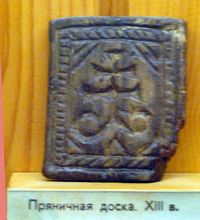 Russian archeologists have found carved wooden boards in medieval layers that they believe were used to mold prianiki, found near structures that could be bakeries.
Russian archeologists have found carved wooden boards in medieval layers that they believe were used to mold prianiki, found near structures that could be bakeries.
The Domostroi has one reference to cookies, соцни, in section 43.
We know that the basic ingredients for prianiki were available to medieval Russians.
Related modern Russian words:
-
бадьян (bad'yan) - anise [Yandex]
вырезный пряник (vyreznyj pryanik) - prianiki decorated with fancy icing [various websites]
гвоздика (gvozdika) - cloves [Katzner]
имбирь (imbir') - ginger [Katzner]
кардамон (kardamon) - cardamom [Yandex]
козуль (kozul') - a type of northern prianik [Russian Folk Art website]
корица (koritsa) - cinnamon [Katzner]
лепешка (lepyoshka) - small cake, crumpet [Katzner]
лепной пряник (lepnoj pryanik) - prianiki formed into little sculptures [prianiki websites]
мед (myod) - honey [Katzner]
мука (muka) - flour [Katzner]
мускат (muskat) - nutmeg [Katzner]
мускатный цвет (muskatnyj tvet) - mace [Katzner]
пекарный порошок (pekarnyj poroshok) - baking powder [Katzner]
печатный пряник (pechatnyj pryanik) - prianiki formed with carved boards [prianiki websites]
печенье (pechen'e) - pastry, cookie [Katzner]
питьевая сода (pit'evaya soda) - baking soda [Katzner]
пряник (pryanik) - cake [Katzner]
пряник, медовый (medovyj pryanik) - honey cake [Katzner]
пряник, имбирный (imbirnyj pryanik) - gingerbread, literally, ginger cake [Katzner]
пряность (pryanost') - spice [Katzner]
соцни (sotsni) - cookie [Pouncy]
тесто (testo) - dough [Katzner]
тетерок (teterok) - a type of northern prianik [Russian Folk Art website]
A relatively simple modern Russian recipe - Medoviya Prianiki (Honey Cookies) from The Best of Russian Cooking:
1 c sifted rye meal 1 c sifted flour 1/2 tsp baking powder 1/2 tsp ground cloves 1 tsp ground ginger 1 tbs gin or whiskey 2 drops anise flavoring (optional) Heat honey in a pan until thin. Let the honey come up to the boil once, then keep it very hot. Sift together rye meal and flour. Add the spices to the flour, mix quickly and add part of the flour to the very hot honey. Stir together then add the rest of the flour mixture, and the rest of the flavorings. Beat it all together as hard as you can with a wooden spoon. Keep beating until the dough comes off the spoon easily. Shape into a long roll, flatten it slightly and cut into slices about 1/2 inch thick. Put on a lightly greased and floured cookie sheet. Bake in a slow oven (325 degrees) till light brown - about 30 minutes. The cookies should come out quite dry. My version of the above:
1 c rye flour (or 1/2 c rye and 1/2 wheat flour) 1/2 tsp cloves 1 tsp ginger 1/4 tsp cardamom Heat honey in a pan until thin. Let the honey come up to the boil once, then keep it very hot. Sift together rye meal and flourAdd the spices to the flour, mix quickly and add part of the four to the very hot honey. Stir together then add the rest of the flour mixture. Beat it all together as hard as you can with a wooden spoon. Keep beating until the dough has come to room temperature. Since it never got to the point where it separated from the spoon so it could be shaped into a long roll, I just pulled off cookie-sized chunks to form individually. Since the dough was very sticky, I had to keep my hands moist with a handy bowl of water. Shape into disks about 1/2 inch thick. Put on a lightly greased and floured cookie sheet. Bake in a slow oven (325 degrees) till light brown - about 30 minutes. See the two sets of light brown cookies on the right side of the big baking sheet in the photos to the right. I also tried a batch at 400 degrees. See the cookies on the small baking sheet in the photos. They got a bit singed. The original batch of cookies (including both the 325 and 400 degree versions above) came out very hard - dangerous to dental work. For the next batches, I flattened the slices to 1/4 inch (instead of 1/2 inch) before baking, and so they came out safely crisp. I divided the original recipe in half for experimental purposes. And I left out the alcohol and baking powder, since neither would have been available in period unless the Russians used hartshorn like the Germans and Scandinavians. I made one batch with only rye flour since rye was much more available in northern Russia than wheat according to archeological finds in Novgorod. The 100% rye cookies had a slightly sparkly appearance (on the left side of cookies sheet) compared with the blended one (on the right side), but they were otherwise undistinguishable. And while all the batches were tasty, none were suitable for molding with a carved board. So I looked for more information.
|
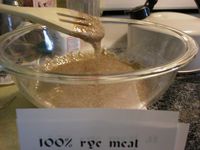
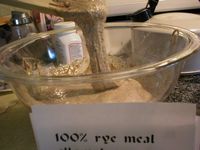
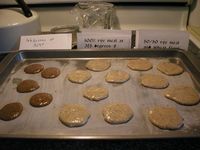

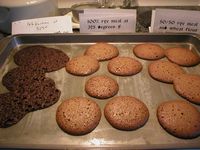
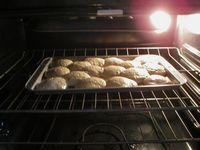
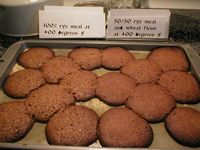
|
|
We have recipes for similar items from Western European cookbooks from the Middle Ages. The most well-known is the gingerbread popularized by Cariadoc's Miscellany based on the 14th century English cookbook Forme of Cury and similar to the recipes in numerous others.
Gingerbrede:
1 tbs sugar 1 c bread crumbs (I used rye bread) 1 tsp cinnamon 30-40 cloves 1 tsp ginger 1/4 tsp pepper Bring honey to boil and simmer 2-3 minutes. Stir in the breadcrumbs with a spatula until mixed. Remove from the heat and add the spices. When cool enough to handle, knead it to make sure spices are thoroughly mixed. oth as possible. Dip the mold in rose water, and mold the cookies. From it as desired, sprinkle with sugar and garnish with the cloves Leave to cool and absorb the flavor of the cloves.
|
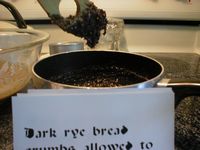
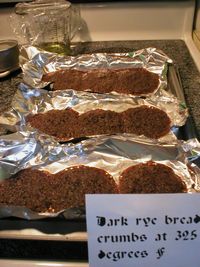
|
More promising as prianiki analogues seemed to be the German lebkuchen. The traditional cookies are molded with wooden boards similar to those used by the Russians, and period German recipes are available. The 16th century cookbook of Sabrina Welserin, Das Kuchbuck der Sabrina Welserin, has three recipes. Even better, or so it seemed, the English translation by Valoise Armstrong is available on-line.
|
#151 Good Lebkuchen 1 qt honey 1 lb sugar 1/3 qt flour 2 ½ oz cinnamon 1 ½ oz cloves Ginger to taste 2 oz cardamom |
#163 Nurnberger Lebkuchen 1 qt honey 1 ½ lb sugar ¼ lb flour 1 ½ oz cinnamon ¾ oz cloves 3 oz ginger 1 ½ oz nutmeg |
#164 Large Nurnberger Lebkuchen 1 qt honey ¼ lb sugar ¼ lb flour ½ oz cinnamon 1 oz cloves 4 oz ginger 1 ¾ oz nutmeg |
My original composite recipe of the above was based mostly on #151 to get a smaller batch:
1/8 c brown/granulated sugar 1/4 c flour 1/2 tbs cinnamon 1 tbs cloves 1/3 c ginger 1/4 tbs mace 1 3/4 nutmeg Boil honey and skim. Stir in sugar, and keep it hot as long as one cooks an egg (5-10 minutes) stirring continually. Pour it hot into the flour. Stir it slowly and add the spices. Stir slowly and not too long. Let the dough set for as long as one needs to hard boil eggs (10 minutes). Dip the hands in flour and make balls out of it, then roll them out as smooth as possible. Dip the mold in rose water, and mold the cookies. Let them set overnight. [As you can see in the picture to the right, the dough was completely unsuitable for rolling out or molding. So no setting out overnight, either.] I baked the cookies at 325 degrees on a floured pan, checking them frequently. They, of course, did not perform at all as decribed by the original recipe, "At first they will become soft as fat. When they are entirely dry, rotate the pan and bake a short while longer." The result was the very dark brown wafers on the left sides of the cookie sheet in the photos. The amount of spices in the recipe was quite excessive, and the amount of flour was completely inadequate. They came out more like cough drops than cookies. Something was clearly very wrong. More research was needed. |




|
Traditional variations on gingerbread such as springerle and the Dutch speculaas are available to help reconstruct what the Russian prianiki may have been like and figure out how to fix the lebkuchen. The wonderful people at Gode Cookery made their name with their Goode Cookies, which are based on the traditional Basler springerle recipe. The recipe is not actually on the Gode Cookery webpage, but I found some versions of springerle on-line.
|
19th c Basler Aenisbroetli/ Springerle 500g powdered sugar 4-5 eggs 500g flour 1 tbs anise Bake at 150-160 degree C for 12-15 minutes. |
Perfection Springerle Cookies (from House on the Hill): 3 c powdered sugar (half to ¾ lb) ¼ c unsalted butter 3 large eggs 4 ¼ cups sifted cake flour 1 tbs milk ¼ tsp harthorn or baking powder (I used baking powder) ¼ tsp anise (I substituted cinnamon, cloves, & ginger) ¼ tsp salt Orange or lemon rind (optional – omitted) Dissolve harthorn in milk and set aside (if use baking powder don’t need milk?). Beat eggs until thick and lemon-colored (10-20 minutes). Slowly beat in powdered sugar, then the softened butter. Add harthorn and milk, salt, and preferred flavorings. Gradually beat in as much flour as possible with mixer, then stir in remainder by hand to make a stiff dough. Turn onto floured surface and knead in enough flour to get a good print without sticking. Imprint and dry cookies using general instructions (found on the House on the Hill website). Bake on greased or baker’s parchment lined cookie sheets at 255-325 degrees till barely golden on the bottom, 10-15 minutes or more, depending on the size of the cookie. Store in airtight container or in zipper bags in freezer. Keep for months and improve with age. Yields 3-12 dozen. |
Speculaas (from House on the Hill): 2 c unpacked brown sugar ¾ c unsalted butter 1 egg 1 c flour 4-6 tbs milk 1 c ground almonds 2 tsp cinnamon ½ tsp cloves ½ tsp ginger ½ tsp mace ½ tsp cardamom ½ tsp salt 2 tsp cocoa (omitted) Rind of one lemon (omitted) Shaved/sliced almonds for base of cookies (omitted) Cream butter and brown sugar. Add egg, ground almonds, then salt and flavorings, and finally work in the flour. Add 4-6 tbs of milk to make a stiff dough. Refrigerate 30-60 minutes. Roll, print and cut out cookies. Brush with milk. Bake at 350 degrees for 10-12 minutes. Yields 30-90 cookies depending on size. |
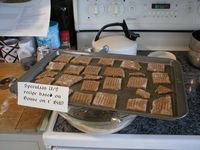
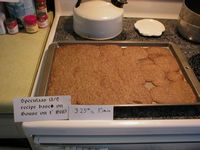

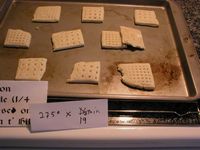
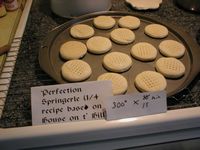
The Speculaas were tasty, but they melted into buttery sweet puddles in the oven, losing their original forms. On the other hand, the "Perfection Springerle" turned out quite well. They molded properly, and kept their shape. They had a delicately spicy flavor and light color. So while they were only a pale reflection of gingerbread, they seem to be a very promising place to start. Time to revisit the "lebkuchen problem".
My original attempt at lebkuchen was based on an English translation. So I was concerned that perhaps the original German had not been translated properly. Conveniently enough, the text is available on-line.
|
<<151>> Gút lezelten zú bachen Nim am ersten ain pfúnd zúcker, ain qúertlin geleúterts honig, nit gar ain fiertellin mell/ nim 5 lot rerlen, 3 lott negellen, 4 lott kerner/ gestossen, die andere wirtz schneid aúffs klainest, die rerlen aúfs grebest gestosen, thú jmber aúch darein/ vnnd thú zúcker in das honig, lasß es mitainander sieden, thús mell jn ain múolter, geúsß die kerner am ersten ein, darnach den jmber vnnd dan die andern wirtzen. |
<<163>> Niernberger lezeltlach zú machen Nim ain masß honig/ thús jn ain grosse pfanen, verfoms woll vnnd lasß ain gúte weil sieden, thú 1_1/2 pfúnd zúcker daran, riers fúr vnd fúr mit ainer hiltznie spatel vnnd lasß also lang sieden/ als lang man ain bar air seúdt, schits also hais jn ain vierling mell, riers gemach vmb vnnd thú das geschriben gewirtz jn taig, riers gemach vnnd nit lang, nim 1 lott rerlen, 3 lot múscat, 1_1/2 lot negellen, 6 lot jmber, ain qúintlin múscatblie, vnnd ain yedes besonder geschniten oder gestossen, das es nit klain seý, grosß gespalten besondern an den rerlen, vnnd wan du das gewirtz jn taig gethan hast, so lasß als lang den taig stan, als man ain hert bar air seúdt, dúnck die hend jn ain mell vnnd nim feine heúflen aús dem taig, mach kigellen daraús, wigs ab, das ains soúil hab als das ander, braits aús mit ainem walgelholtz, streichs glat mit der hand, ýe gleter ýe hibscher/ dúnck darnach den model jn ain rossenwasser vnnd drúcks daraúff, nim 8 lot taig zú ainem zeltlin/ hiet dich, thú kain mell darein, dan sý wúrden nit gút, aber aúfs bret magst woll mell thon/ das sý nit aúffhafften, lasß jber nacht ligen/ vnnd wan dú es zom becken tregst, so lúg, das dú ain ander bret habest, das besee gantz woll mit mell, das gantz dick beseet seý, thú das bret mit dem besetten mell jn bachoffen, das das bret gantz haiß werd, ýe haiser ye pesser/ thús darnach heraús, leg die lezelten darauff, das kains das ander anrier, thús jn offen, lasß bachen vnnd sich offt darzú, am ersten werden sý lind als ain schmaltz, wan dú daraúffgreifst, so entpfindsts woll/ vnnd wen sý gantz drúcken werden, so thús heraús vnnd ker das bret vmb, das das forderthail hinden jn offenn kom, lasß ain klaine weil stan/ darnach thús heraús, nim ain kerwischlin, ker das mell saúber am boden herab vnnd leg die lezelten dieweil aúff ain ander pret, bis dú ain lezelten nach dem andern abkert hast/ das kain mel am boden seý/ darnach ker das mel am boden gantz sauber herab, leg die lezelten wider daraúff, das der boden an den lezelten jbersich kert werd, nim ain badtschwam, stos jn jn ain rossenwasser, drúck jn wider aús, wesch das mell ab dem boden/ aúff dem pret, lúg, das dir kain wasser aúff das pret kum, dan sý wúrden anhafften, thú darnach das bret mit den lezelten wider in bachoffen, die poden fein aúfgond vnnd hert werden, so thú das bret wider heraús, lúg, das 2 oder dreý beim bret seyen, die behend die lezelten vmbkeren, wan sý wúrden sonst anhaften, darnach nim ain rossenwasser vnnd wesch oben mit ab, wie dú vnnden am boden gethan hast, thús wider jn offen, lasß drúcken werden, trags haim, riers am bret, das nit anhefften, vnnd wann sý woll erkalten seind, so leg 8 oder zechnen aúfainander, winds jn ain bapir, behalts sý an drúcknen orten, das kain lúfft daran kan, so bleiben sý resch. |
<<164>> Ain grossen nierenberger lezelten zú machenn Nim ain masß honig vnnd aúch ain halben vierdúng zúcker, thú jm wie mit den klainen lezelten, nim ain 1/2 fierling mell vnnd dan gewirtz wie nachfolgt, 1 lot rerlach, 2 lott negellach, 3_1/2 lot múscat, 8 lot jmber, 1/2 lot múscatblie, rúrs gemach vmb, darnach well jn ain wenig aúsß, bach jn wie die klainen lezelten. |
Pulling out the ingredients with their amounts:
|
<<151>> Gút lezelten zú bachen
ain pfúnd zúcker |
<<163>> Niernberger lezeltlach zú machen
ain masß honig |
<<164>> Ain grossen nierenberger lezelten zú machenn
ain masß honig |
So there are several units of measure that must be translated: fierling, fiertellin, lot, lott, masß, pfund, quertlin, quintlin, vierdung, vierling.
Fierling - since the German "v" is often pronounced like an "f" and the fierling in 164 is used the same way as "vierling" in recipe 163, the fierling is obviously an alternate medieval spelling of vierling. See below.
Fiertelling - likely meant to be viertellin, an alternate medieval spelling of vierteln, more commonly known as viertel.
Lot - an alternate spelling of loth. All my references agree that a lot/loth is 1/2 oz.
Lott - I believe that this is an alternate spelling of lot. However, this would leave recipe #151 very over-spiced. (Recipes #163 and 164 fare a bit better.) A fellow researcher, Marion McNealy aka Lady Sophia Kress, believes that a lott is a more diminutive measurement, much like a tsp is smaller than a TBS, and she converts the measurement to a pfennig, which is 1/16th of a loth, in her redactions. She reports good results - better than I have gotten redacting the lott as the same as lot. See below.
Masß - an alternate spelling of Maß, often written in English texts as mass, maass, maz, etc. The Augsburg maass was 0.38 gallons, i.e. 1.4 liters/quarts or about 5 1/4 cups. [Alexander & Brown]
Pfund - directly translates as pound in English. It varied in size a bit from place to place, but not enough to worry about too much (466-560 g, with the modern pound = 500g). The Augsburg pfund was 1.23 lb. However, commodities such as spices and sugar were sold by apothecaries. The apothecary pfund in Bavaria (where Augsburg is located) was 0.8 lb, which is about 2 1/4 cups of flour by my calculations. [Alexander & Brown]
Quertlin - apparently an alternate spelling of quaartlein or quartel. The Augsburg quertel and the Graubundten quaartlein are both about 0.09 gallons or 0.37 quarts or 1.5 cups. [Alexander & Brown]
Quintlin - the quintleinin in Ratisbor is 0.16 oz or 1/3 loth according to Alexander. This is very similar to the size listed in Alexander & Brown for the Augsburg quentche - 1/4 of a loth or 0.13 oz.
Vierdung - alternate spelling of vierdunc. This is another unit with multiple possible meanings related to the fact that "vier" is the German word for "four", so it often means a quarter of something. Thus it is often synonymous with "vierling", particularly as a unit of volume and comes in a bewildering range of amounts (see below). However, as a unit of weight, it is most often 1/4 pfund according to several on-line Middle High German dictionaries. And in recipe #164, where it indicates the amount of sugar, it seems most likely to be meant as a unit of weight like the other two recipes.
Vierling - a unit of measure ranging from 1/4 quart to 6 liters (6 quarts). I had a couple of sources that indicated that a vierling is equivalent to a viertel, which can be as large as 15 liters. However, the Augsburg vierling is 0.18 bushels or 6.4 liters/quarts. [Alexander & Brown]
The above indicate that the Armstrong translations of the original German are quite a bit off for the flour, and perhaps a bit off for the sugar, depending on whether one should use a standard pfund or an apothecary pfund. These items are critical for the final result. I'm not as concerned about the lot/lott question, since I'll be adjusting the spices based on comparison with the Russian recipes that I've found.
|
#151 Armstrong trans. 1 qt honey 1 lb sugar 1/3 qt flour 2 ½ oz cinnamon 1 ½ oz cloves Ginger to taste 2 oz cardamom |
#151 Revised 1 qt honey 3/4 lb sugar 1/3 qt flour 2 ½ oz cinnamon 1 ½ oz cloves Ginger to taste 2 oz cardamom (Still too much spice!) |
#163 Armstrong trans. 1 qt honey 1 ½ lb sugar ¼ lb flour 1 ½ oz cinnamon ¾ oz cloves 3 oz ginger 1 ½ oz nutmeg |
#163 Revised 1.3 qt honey 1 lb sugar 6 qt flour 1/2 oz cinnamon 3/4 oz cloves 3 oz ginger 1 1/2 oz nutmeg |
#164 Armstrong trans. 1 qt honey ¼ lb sugar ¼ lb flour ½ oz cinnamon 1 oz cloves 4 oz ginger 1 ¾ oz nutmeg |
#164 Revised 1.3 qt honey 1/8 lb sugar 3 qt flour 1/2 oz cinnamon 1 oz cloves 4 oz ginger 1 3/4 oz nutmeg |
My lebkuchen friend (see discussion of "lott vs lot" above), reports that recipe #164 is the best for getting a nice, moldable cookie. Recipe #151 gave her a lovely golden leaf-like cookie (she used far less spice) that matches an alternate form of lebkuchen that she has found references to. (And the original recipe of prianiki I tried, interestingly enough.) Since I was interested in a moldable cookie, I concentrated on recipe #164.
|
Prianiki re-visited:
I decided to see what would happen with the prianiki recipe if I put the baking powder back in. I also replaced the cardamom with anise, since some of the Russian recipes do the same.
1 c rye flour 1/2 tsp baking powder 1/2 tsp cloves 1 tsp ginger 1/4 tsp ground anise Heat honey in a pan until thin. Let the honey come up to the boil once, then keep it very hot. Sift together rye meal and flour. Add the spices to the flour, mix quickly and add part of the flour to the very hot honey. Stir together then add the rest of the flour mixture. Beat it all together as hard as you can with a wooden spoon. Keep beating until the dough has come to room temperature. Since the dough never got to the point where it separated from the spoon so it could be shaped into a long roll, I just pulled off cookie-sized chunks to form individually into disks about 1/4 inch thick. (Since the dough was very sticky, I had to keep my fingers moist with a handy bowl of water.) Put on a lightly greased and floured cookie sheet. Bake in a slow oven (325 degrees) till light brown - about 30 minutes. The only difference I noticed with the baking powder is that the cookies seem to be a little more foamy as they baked, and ran together more, than the version without baking powder. I didn't particularly like the anise, either.
|
Welserin's Nurnberger Lebkuchen #164 (1/8th recipe)
generous 1/2 tsp sugar (should have been 1/2 tbs - oops) 1 1/2 c flour 1/4 TBS cinnamon 1/2 TBS cloves 2 TBS ginger 3/4 TBS nutmeg 1/8 TBS mace Boil honey and skim. Stir in sugar, and keep it hot as long as one cooks an egg (5 minutes) stirring continually. Pour it hot into the flour. Stir it slowly and add the spices. Stir slowly and not too long. Let the dough set for as long as one needs to hard boil eggs (10 minutes). Dip the hands in flour and make balls out of it, then roll them out as smooth as possible. Dip the mold in rose water, and mold the cookies. Let them set overnight. Bake the cookies on a floured pan (at 325 degrees) until they are dry, checking them frequently. At first they will become soft as fat. Brush the flour off the bottoms. The cookies molded nicely, and kept their shape throughout baking. I tried to leave the cookies in the oven until they looked "dry". However after 20 minutes, the cookies still didn't "look dry" and they had started to smoke a bit, although none were actually burned. They came out of the oven rubbery and bendable, but soon became rock hard. Definitely a dunking cookie at that point (as some of my sources on traditional lebkuchen would indicate). It would be better if I had pulled them out at 8-11 minutes like Marion McNealy does. And in the end, the spice content was edible, but a little too strong and mediciney to be pleasant for me. Note that for this experiment, I went with the lot=lott=loth units for the spices - just for fun. I will leave further speculations on the lot/lott problem to others who are actually researching German cookery and base my future spices on Russian sources.
|

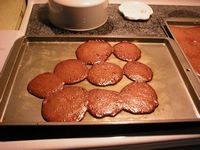
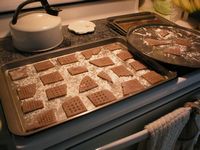

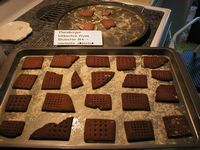
The next stage of baking experiments:
|
Plausible Moldable Prianiki #1 (mostly Welserin #164, Kropotkin-like spices): 1 c honey 3 c flour 1/2 tsp cloves 1 tsp ginger 1/4 tsp cardamom Boil honey and skim. Stir in sugar, and keep it hot as long as one cooks an egg (5-10 minutes) stirring continually. Pour it hot into the flour. Stir it slowly and add the spices. Stir slowly and not too long. Let the dough set for as long as one needs to hard boil eggs (10 minutes). Dip the hands in flour and make balls out of it, then roll them out as smooth as possible. Dip the mold in rose water, and mold the cookies. (Let them set overnight.) Bake the cookies on a floured pan at 325 degrees until they are dry, checking them frequently, about 8 minutes. When they are entirely dry, rotate the pan and bake a short while longer (3 more minutes). Brush the flour off the bottoms. (Omitted the rose water sponging and oven drying steps that follow here in original recipe). |
Plausible Moldable Prianiki #2 (mostly Welserin #164, Goldstein-like spices): 1 c honey 3 c flour 1/2 tsp cinnamon 1/2 tsp ginger 1/2 tsp mace 1/2 tsp cardamom Boil honey and skim. Stir in sugar, and keep it hot as long as one cooks an egg (5-10 minutes) stirring continually. Pour it hot into the flour. Stir it slowly and add the spices. Stir slowly and not too long. Let the dough set for as long as one needs to hard boil eggs (10 minutes). Dip the hands in flour and make balls out of it, then roll them out as smooth as possible. Dip the mold in rose water, and mold the cookies. (Let them set overnight.) Bake the cookies on a floured pan at 325 degrees until they are dry, checking them frequently, about 8 minutes. When they are entirely dry, rotate the pan and bake a short while longer (3 more minutes). Brush the flour off the bottoms. (Omitted the rose water sponging and oven drying steps that follow here in original recipe). |
Plausible Moldable Prianiki #3 (mostly Welserin #164, Speculaas spices): 1 1/4 c honey 1/2 tbs turbinado sugar 3 c flour 2 tsp cinnamon 1/2 tsp cloves 1/2 tsp ginger 1/2 tsp mace 1/2 tsp cardamom Boil honey and skim. Stir in sugar, and keep it hot as long as one cooks an egg (5-10 minutes) stirring continually. Pour it hot into the flour. Stir it slowly and add the spices. Stir slowly and not too long. Let the dough set for as long as one needs to hard boil eggs (10 minutes). Dip the hands in flour and make balls out of it, then roll them out as smooth as possible. Dip the mold in rose water, and mold the cookies. (Let them set overnight.) Bake the cookies on a floured pan at 325 degrees until they are dry, checking them frequently, about 8 minutes. When they are entirely dry, rotate the pan and bake a short while longer (3 more minutes). Brush the flour off the bottoms. (Omitted the rose water sponging and oven drying steps that follow here in original recipe). |
Prianiki-like Springerle (Perfection Springerle with honey and more spices): 1 1/2 c honey 3/4 c butter 3 eggs 4 3/4 cups sifted flour 1 tbs milk 1/4 tsp baking powder 1 tsp cinnamon 1/2 tsp cloves 1/2 tsp ginger Dissolve baking powder in milk and set aside. Beat eggs until thick and lemon-colored (10-20 minutes). Slowly beat in the honey, then the softened butter. Add harthorn and milk, salt, and preferred flavorings. Gradually beat in as much flour as possible with mixer, then stir in remainder by hand to make a stiff dough. Turn onto floured surface and knead in enough flour to get a good print without sticking. Imprint and dry cookies using general instructions. Bake on greased or baker’s parchment lined cookie sheets at 300 degrees till barely golden on the bottom, approx. 15 minutes, depending on the size of the cookie. |
All three of the Plausible Prianiki recipes gave a lovely, play-dough-like dough that just begged to be shaped in all sorts of ways. Number 3 ended up with a little more honey than the other two, oops. I don't know if it was that or the addition of the sugar that gave the dough a slightly different texture than the other two versions (as you can see in the photo below). It also puffed up a little more as it baked. For better or worse. They all came out dry and firm, but easy on the teeth. As for the spices, I liked the blend in #3 the best.
The Prianiki-like Springerle turned out quite nice as well, since I miraculously converted the powdered sugar to honey right the first time. With the butter and egg, they taste richer than the Plausible Prianiki and the spices are a little more mellow. But the butter and egg mean that one could not eat them on Fast Days.
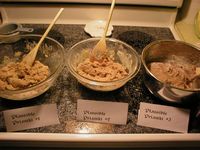
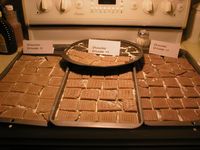
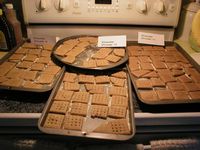
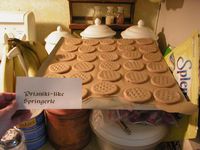
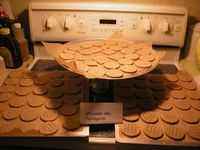
|
As I was baking the above, I found some new Russian-language webpages about prianiki discussing three different types - the most ancient (lepnye) are formed into little animals (remember that tempting play-dough consistency?), the most popular (pechatnye) are molded with wooden molds, and the most beautiful (vyreznye) are decorated with intricate colored frosting.
http://ricolor.org/history/hr/byt/pryanic/ And this webpage included several recipes:
http://www.sampo.ru/~lushma/print.htm The lepnye prianiki are apparently just flour, salt and water. Cinnamon and cloves are the spices in three of the five recipes for Archangel-style vyreznye prianiki. The other two recipes add cardamom and anise to the cinnamon and cloves. There is no ginger in these recipes. There wasn't a recipe specifically for the pechatnye prianiki. I would expect it to be similar to the vyrezyne prianiki recipes. This webpage has some very interesting bits of ethnographic information about these cookies.
|



|
References:
- Alexander, J. H. Universal Dictionary of Weights and Measures, Ancient and Modern, Reduced to the Standards of the United States of America. Baltimore: W. Minifie and Co, 1850. http://books.google.com/books?id=LnUAAAAAMAAJ
- Armstrong, Valoise, translator. Das Kuchbuch der Sabina Welserin http://www.daviddfriedman.com/Medieval/Cookbooks/Sabrina_Welserin.html
- Atlas, Alia, translator. Ein Buch von guter spise. http://cs-people.bu.edu/akatlas/Buch/buch.html
- Browne, William Alfred. The Merchants' Handbook of Money, Weights and Measures, with Their British Equivalents. London: Edward Stanford, 1879. http://books.google.com/books?id=GJABAAAAQAAJ
- Cariadoc's Miscellany.
- Das Deutsche Wörterbuch von Jacob und Wilhelm Grimm auf CD-ROM und im Internet. http://germazope.uni-trier.de/Projects/DWB
- Deutsches Rechtswörterbuch. http://www.rzuser.uni-heidelberg.de/~cd2/drw/lv/Q-Uvar.htm
- House on the Hill, Inc. On-line Store. http://www.houseonthehill.net/
- Kropotkin, Alexandra. The Best of Russian Cooking. Charles Scribner's Sons, New York. 1964.
- Mittelhochdeutsches Handwörterbuch von Matthias Lexer. Zugleich als Supplement und alphabetischer Index zum Mittelhochdeutschen Wörterbuche von Benecke-Müller-Zarncke. Nachdruck der Ausg. Leipzig 1872-1878 mit einer Einleitung von Kurt Gärtner. 3 Bde. Stuttgart: S. Hirzel 1992. Found online at http://germazope.uni-trier.de/Projects/WBB/woerterbuecher/lexer/wbgui?lemid=LA00001
- Mittelhochdeutsches Wörterbuch. Mit Benutzung des Nachlasses von Georg Friedrich Benecke ausgearbeitet von Wilhelm Müller und Friedrich Zarncke. Nachdruck der Ausgabe Leipzig 1854-1866 mit einem Vorwort und einem zusammengefaßten Quellenverzeichnis von Eberhard Nellmann sowie einem alphabetischen Index von Erwin Koller, Werner Wegstein und Norbert Richard Wolf. 4 Bde. u. Indexbd. Stuttgart: S. Hirzel 1990. http://germazope.uni-trier.de/Projects/WBB/woerterbuecher/bmz/wbgui?lemid=BA00001
- Novgorod Chronicle.
- Primary Chronicle food references
- Pouncy, Carolyn, editor and translator. The Domostroi: Rules for Russian Households in the Time of Ivan the Terrible. Cornell University Press. Ithaca, NY. 1994.
- Rabinovich, M.G. Очерки Материальной Культуры Русского Феодального Города (Sources of Material Culture of the Russian Feudal City). Nauka. Moscow. 1988.
- Rowlett, Russ. A Dictionary of Units of Measurement. Copyright 2005. http://www.unc.edu/~rowlett/units/index.html
- Russian Folk Art - www.rusfolkart.ru/rus/7/kozula.html
- Sizes.com, the On-line Quantinary. http://www.sizes.com
- Sudakov, G.V. Translated by Lisa Kies. Монастырская Трапеза в XVI Веке. (Cloister Meal of the 16th Cent.) http://www.strangelove.net/~kieser/Russia/cloistermeal.html (12 April 2007).
- Thompson, M.W. Novgorod the Great. Frederick Praeger, Publishers. New York. 1967.
- Tone's Club Volume to Weight Conversion Table [for spices]. http://www.tones.com/spiceInsights.html
- Welserin, Sabina. Das Kochbuch der Sabina Welserin (c. 1553) at http://www.uni-giessen.de/gloning/tx/sawe.htm
- Wikipedia.
- Zasurtsev, P.I. "Жилища Древнего Новгорода: Усадьбы и Построики Древнего Новгорода" (Yards and Buildings of Ancient Novgorod) Материалы и Исследования по Археологии СССР No 65. (Materials and Research in the Archeology of the USSR) Izdatel'stvo Academii Nauk USSR. Moscow. 1958.
- Zasurtsev, P.I. "Жилища Древнего Новгорода: Усадьбы и Построики Древнего Новгорода" (Preliminary Report of Buildings of Ancient Novgorod) Материалы и Исследования по Археологии СССР No 123. (Materials and Research in the Archeology of the USSR) Izdatel'stvo Academii Nauk USSR. Moscow. 1963.
COPYRIGHT (c) 2008 by Lisa Kies. You may make copies for personal use and to distribute for educational purposes but only if articles remain complete and entire with original authorship clearly noted.
Send comments and questions to lkies@jumpgate.net
Back to Russian Material
